Club mushrooms (Clavariadelphus) are among the most recognizable fungi in North America. Their characteristic club-like or bowling pin shape makes them easy to identify among forest debris. Although, it’s sometimes tricky to see them because they’re small, grow on the ground, and blend right in with the surrounding leaf litter. This guide covers six of the most well-known club mushrooms in North America.
- Scientific Name: Clavariadelphus
- Common Names: Fairy Club, Club Mushrooms
- Habitat: On the ground in association with specific trees
- Edibility: Varies, not especially choice
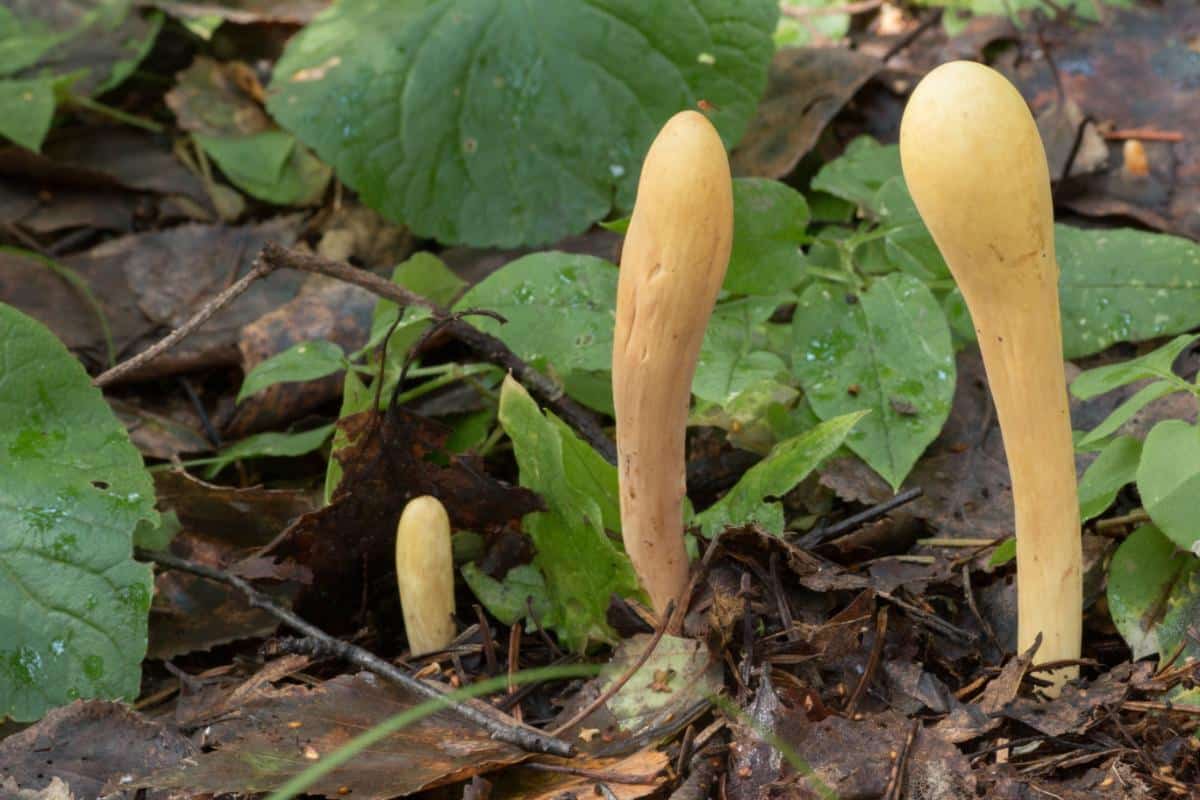
Jump to:
All About Club Mushrooms
Club fungi grow alone or in scattered small groups in the woods. Their unique structure gives these fungi their name. Unlike regular mushrooms with caps and stems, club mushrooms grow as single, elongated clubs that gradually taper from bottom to top.
These mushrooms grow between 2 to 12 inches tall, though most species are only about 4 to 6 inches high. They have a smooth exterior that is pale yellow to rich brown, sometimes with hints of orange or cinnamon. As these mushrooms age, they often develop interesting patterns and slight wrinkles along their surface.
Unlike many other mushrooms that emerge and mature quickly, club fungi take their time developing their characteristic club shape. They begin as tiny finger-like projections that slowly stretch and expand to full size. Young specimens have firm, solid flesh that becomes more fibrous with age.
Club mushrooms are mycorrhizal, meaning they form specific relationships with trees. They grow on the ground but only with the preferred tree species.
The Clavariadelphus genus is a group of fungi that belongs to the family Clavariadelphaceae. These fungi are commonly known as club corals or fairy clubs due to their distinctive club-shaped fruiting bodies. The generic name “Clavulinopsis” is derived from the Latin word “clavaria,” meaning shaped like a club, and the Greek word “adel’phos,” meaning brother. This suggests that fungi in this genus are closely related to those in the genus Clavaria, as they share a similar shape.
The genus was first established by the American mycologist Alexander H. Smith in 1947. Before this, many of the species now classified under Clavariadelphus were initially placed in the genus Clavaria.
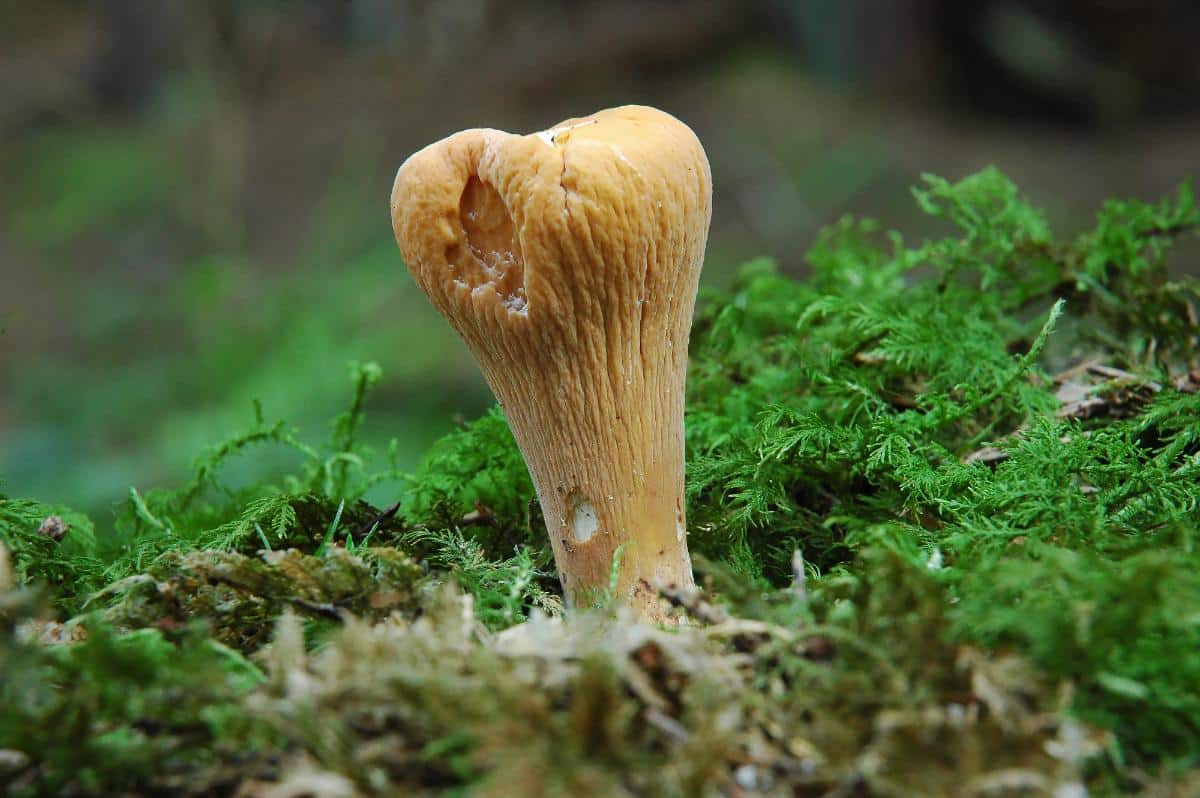
Club Mushrooms Identification
Season
Club mushrooms appear from late August through November in most areas.
Habitat
These mushrooms grow scattered or grouped in coniferous or mixed deciduous-coniferous forests. They pop up from the forest floor and form small colonies where moisture and shade are just right. Club mushrooms always grow from the ground, never from trees or wood.
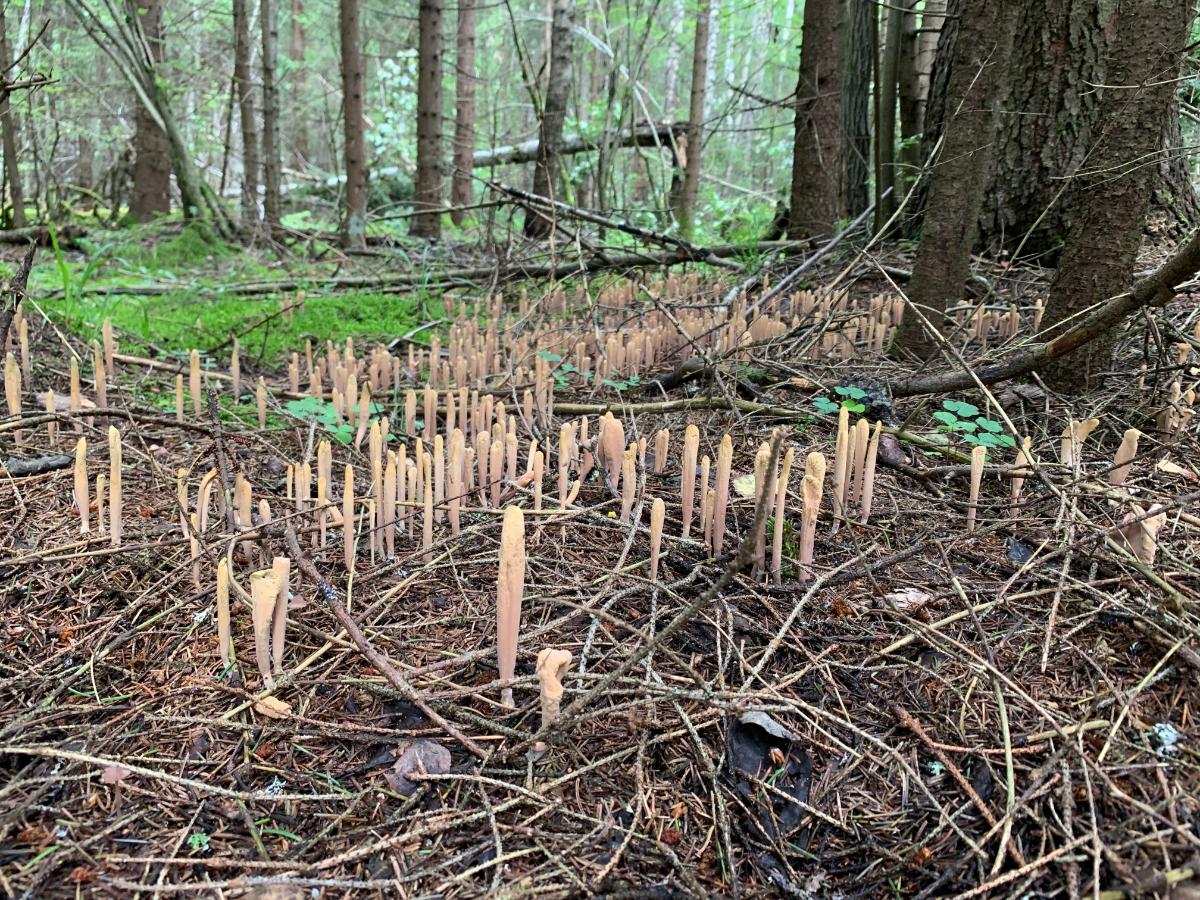
Identification
Body
Club fungi have club-shaped bodies that grow 3-15 inches tall and 1-5 inches wide. The outer surface starts smooth but gets wrinkly and grooved as it ages. The base of the club is pale and often has white hairs. The stem and cap merge naturally to create that club-like shape we all know.
Flesh and Staining
The flesh is white to cream-colored. It is spongy, especially at the top of the club. If damaged, some species change color – usually turning reddish-brown.
Smell and Taste
Most species don’t have a strong smell. The taste can vary greatly – from mild to bitter and even sweet in some cases.
Spore Print
Depending on the species, the spore print ranges from white to pale yellowish-buff.
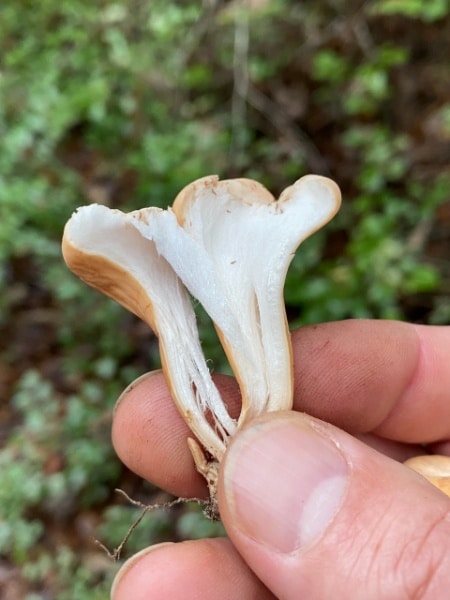
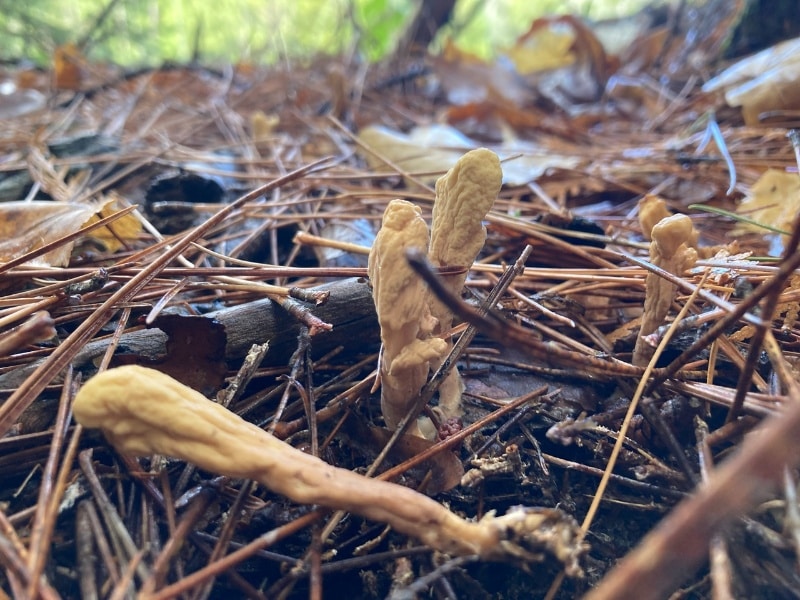
North American Club Mushrooms
American Club (Clavariadelphus americanus)
The American club fungus has a club-like or pestle-shaped fruiting body. It typically grows 4 to 8 inches (10 to 20 cm) tall and 1 to 2 inches (2.5 to 5 cm) wide at its broadest point. The fungus starts out as a slender, cylindrical structure and gradually expands towards the top. The top of the club is rounded, and the entire mushroom is smooth when young.
The surface can range in color from pale yellow to ochre or light brown. With age, it is usually a shade of cinnamon brown. As the mushroom matures, it may develop a slightly wrinkled or pitted texture, especially near the top. The flesh is white to pale yellow and has a firm, fibrous consistency. It may stain reddish-brown when cut.
This species is found growing with pine or oak trees. It is widely distributed in the eastern United States. American clubs have a white spore print.
This mushroom looks identical to Clavariadelphus pistillaris, which also grows in eastern North America. Often, the only way to tell them apart is to look at the trees. C. pistillaris grows with beech trees while the American club grows with pines or oaks. Because it looks exactly like C. pistillaris, it also looks identical to Clavariadelphus occidentalis. It is easy to rule out that species, though, as it only grows on the west coast.
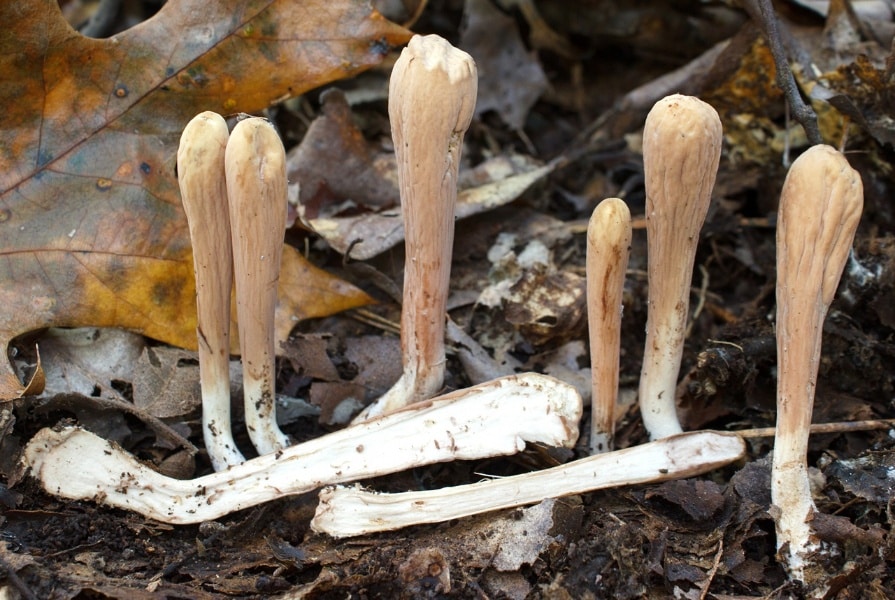
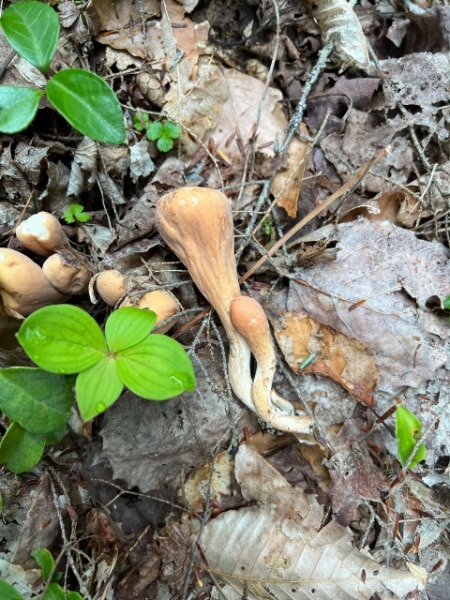
Strap Coral (Clavariadelphus ligula)
The strap coral club mushroom, also known as the “leather club,” has a club-shaped or tongue-like fruiting body. It typically grows 2 to 5 inches tall and 0.4 to 1.2 inches wide. The fungus is usually unbranched, though occasionally it may show slight branching near the top. The surface is smooth when young but usually wrinkles with age.
The color of the strap coral mushroom can vary but is generally pale. Young specimens are often whitish or cream-colored, then gradually change to pale yellow, ochre, or light brown as they age. The interior flesh is white and does not change color when cut or bruised.
The texture of the fruiting body is firm and somewhat rubbery when fresh. As it ages, it may become more leathery or even slightly brittle. The upper portion is usually more spongy, while the lower body is firmer. The spore print is light yellow-orange.
The strap coral club is typically found growing on the ground in coniferous forests. It grows in dense, scattered patches. This species is widespread in the northern US but has also been found in the southwest. It is seemingly absent from the southeast.
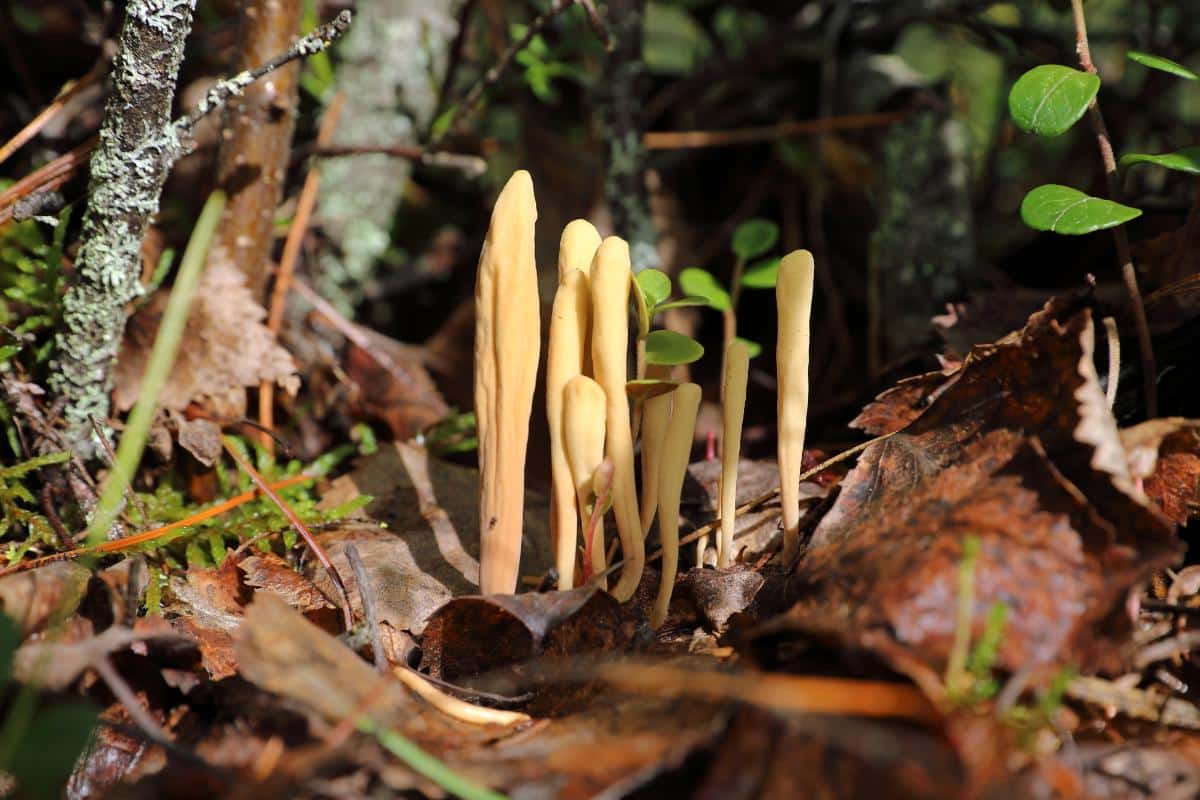
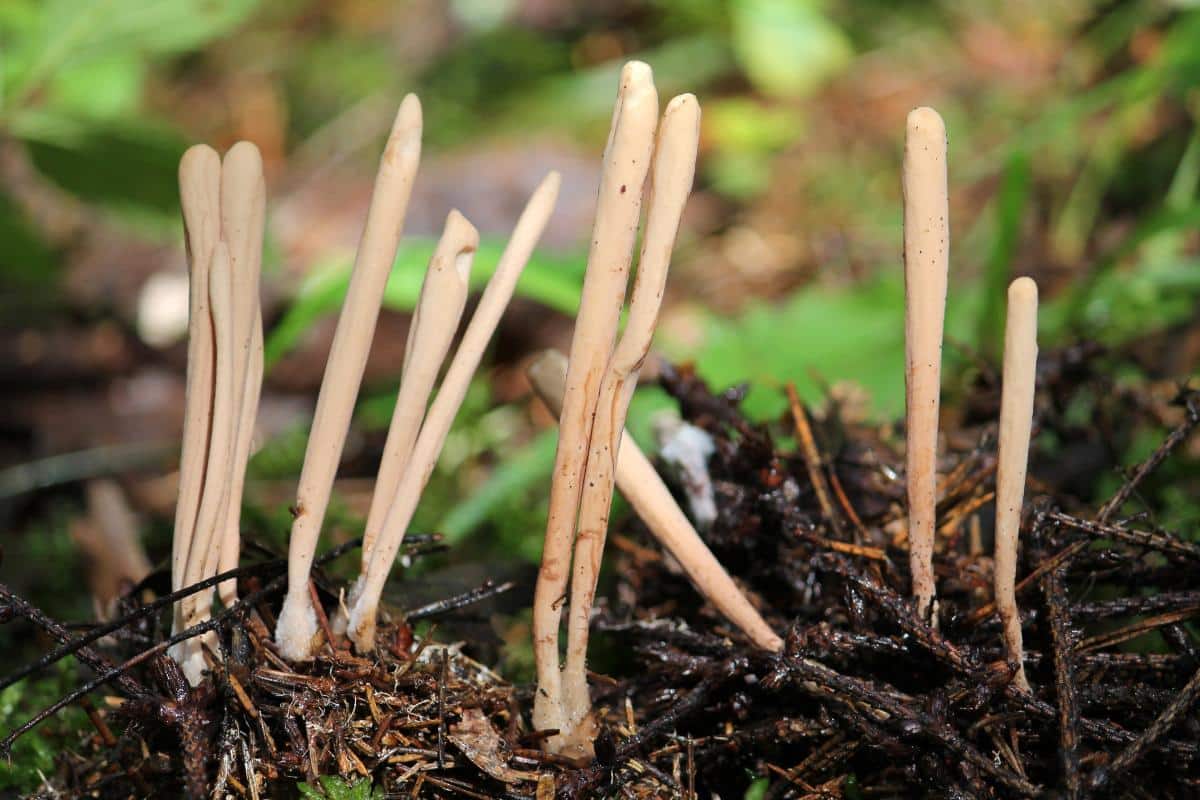
Common Club Coral (Clavariadelphus pistillaris)
The common club coral has the characteristic club-like or pestle-shaped fruiting body. It typically grows as a single, upright structure without branches. The fungus starts small and gradually enlarges upwards, creating its distinctive shape. The top of the club is rounded, not pointed.
The fruiting body of the common club coral is quite large compared to many other club fungi. It usually ranges from 4 to 10 inches (10 to 25 cm) in height. The width at the top can reach up to 2 to 3 inches (5 to 7.5 cm) in diameter.
When young, the mushroom is pale yellow to ochre in color. It darkens to a rich golden brown or cinnamon brown as it matures. The top of the club often becomes darker than the base. The surface of C. pistillaris is generally smooth, but it can become slightly wrinkled or furrowed with age, especially near the top. The flesh is white and firm when fresh.
This species is widespread but rare. It is found almost exclusively with beech trees, often among leaf litter.
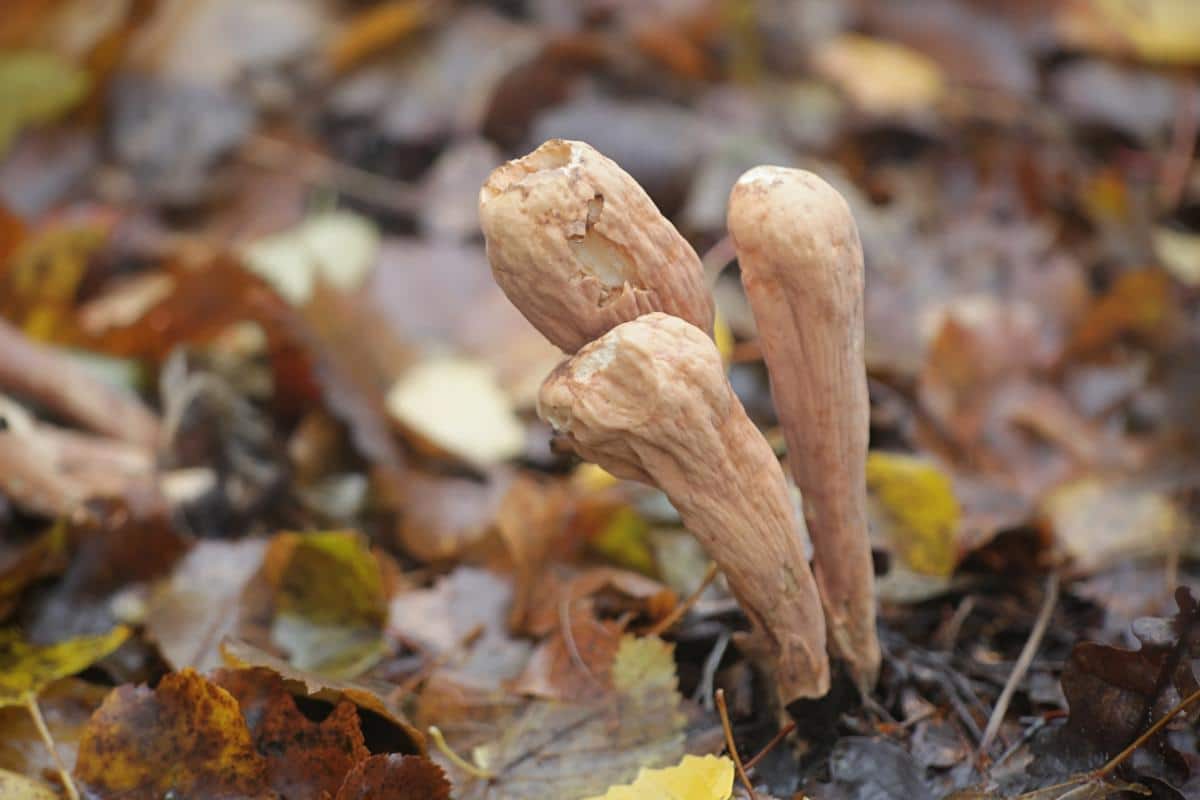
Truncate Club Coral (Clavariadelphus truncatus)
The truncate club coral has the species-unique club-like or column-shaped fruiting body. As its name suggests, the most distinguishing feature is its flat or truncated top, which sets it apart from other club fungi, which generally have rounded tops. The mushroom starts out as a slender, upright column and gradually expands towards the top as it matures. Fully grown specimens typically reach a height of 3 to 6 inches, with the upper part widening to about 1 to 2 inches in diameter.
The color of the truncate club coral can vary but is generally yellowish-orange. As the mushroom ages, it may develop a slightly darker color, sometimes taking on a pinkish or brownish tinge. The flat top is often a lighter shade than the rest of the fruiting body.
The surface of the mushroom is smooth to slightly wrinkled. The flesh is firm and solid, becoming more fibrous towards the base. When cut or bruised, the flesh may slowly change color to pinkish or brownish. The spore print is white to pale yellow.
The truncated club coral grows on the ground in coniferous forests, particularly those dominated by fir, spruce, or pine trees. It prefers mature forests and is often spotted among the needle litter on the forest floor.
This species is edible and has a mild odor and sweet taste. Mushroom expert David Arora says that the sweet flavor makes it dessert-like. Some people call these mushrooms “sweet thumbs,” which is a spectacular name for them.
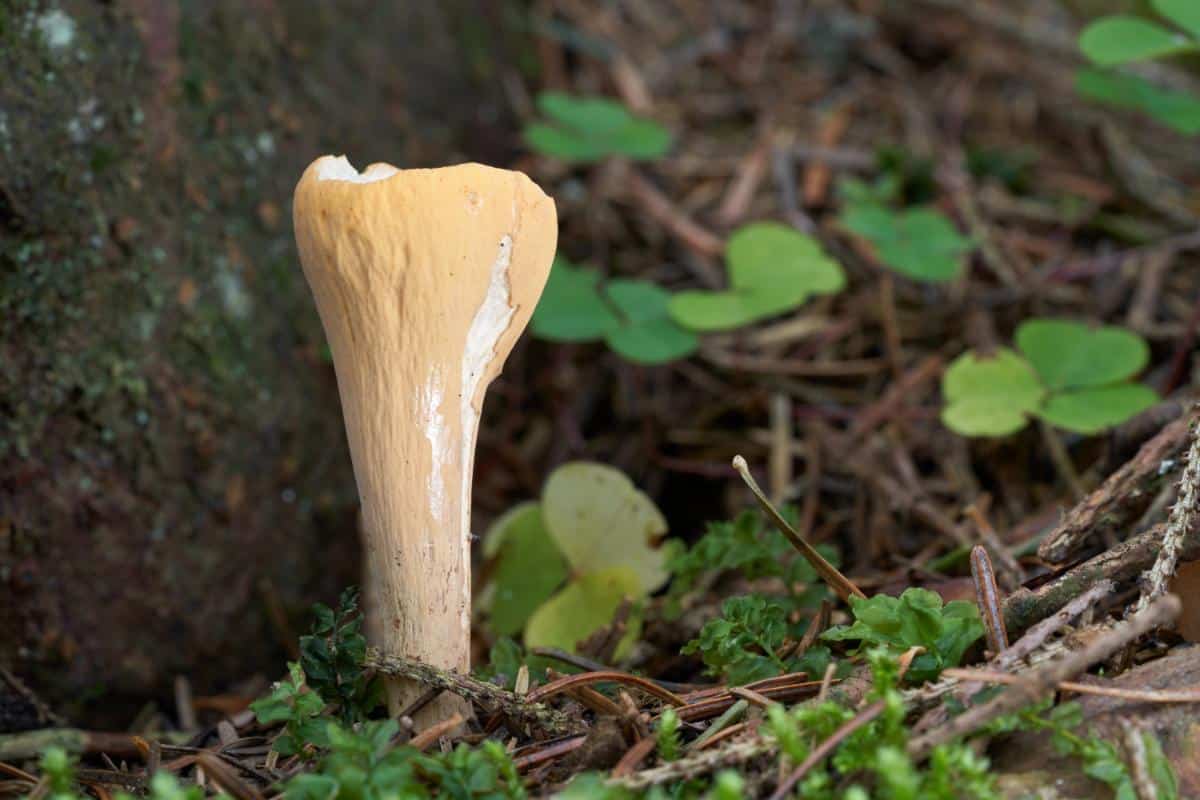
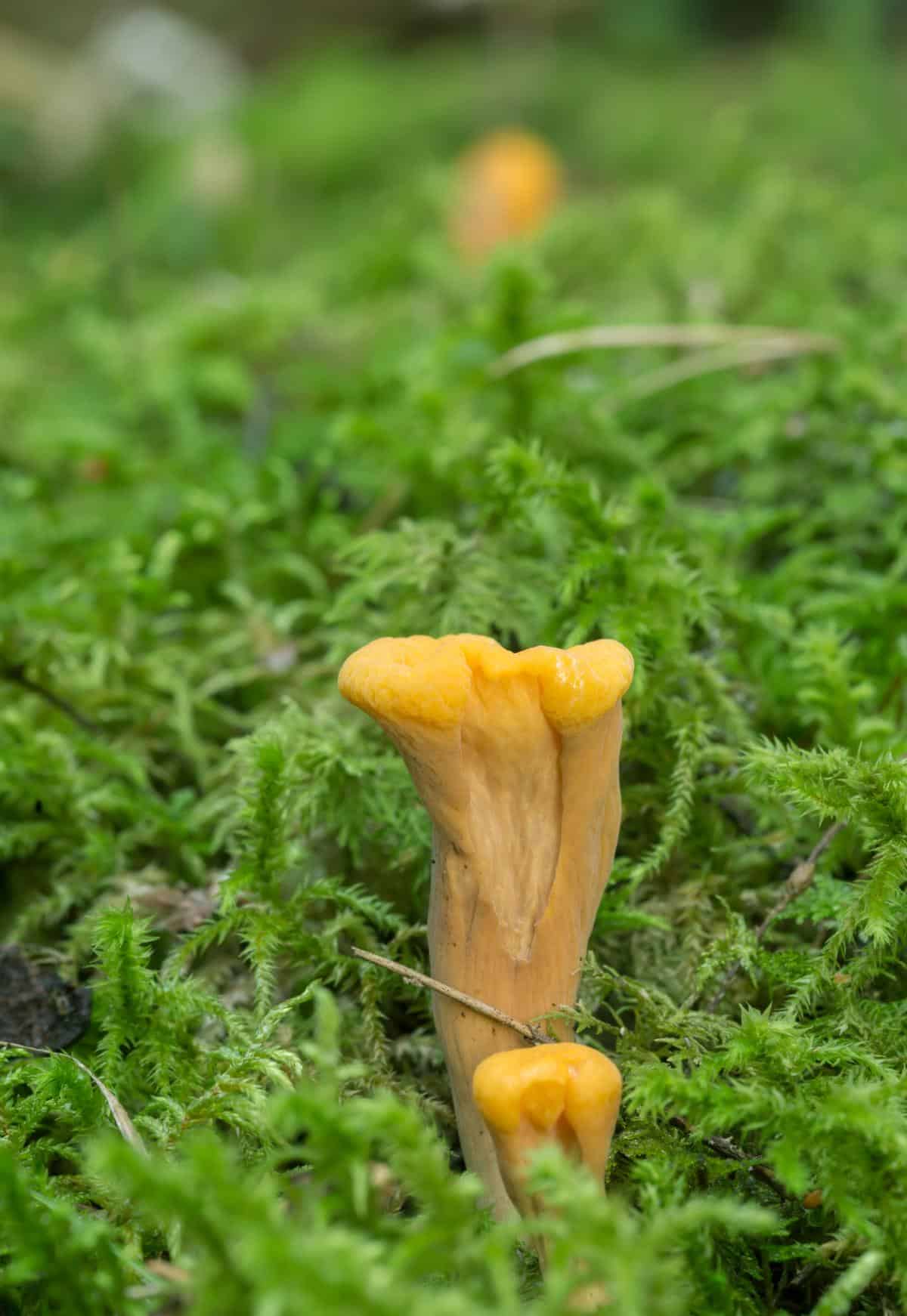
Unicolor Club Coral (Clavariadelphus unicolor)
The unicolor club coral grows in the characteristic club-like or column-like shape. The fruiting body is usually 2 to 6 inches (5 to 15 cm) tall and 0.4 to 1.2 inches (1 to 3 cm) thick. It often has a slightly bulbous or swollen base and a rounded or flattened top. It looks like someone lobbed the top off of the mushroom. With age, the center indents and the edges of the club stretch upwards to create a shallow vase.
As its name suggests, C. unicolor is characterized by its uniform coloration. The entire fruiting body is typically a pinkish to reddish brown. However, the exact shade can vary slightly depending on age and environmental conditions. The surface of C. unicolor is generally smooth but can become slightly wrinkled or furrowed with age, especially near the top. The flesh is white, firm, and fibrous, becoming more brittle as the mushroom matures. The flesh may stain reddish-brown when cut. The spore print is white.
The unicolor club coral grows with oak and pine trees. It often fruits in small groups or scattered individuals on forest floor among needle litter. This species is widely distributed across eastern North America and also appears in Texas. However, it is tough to find because the reddish-brown coloring blends right in with fall leaves.
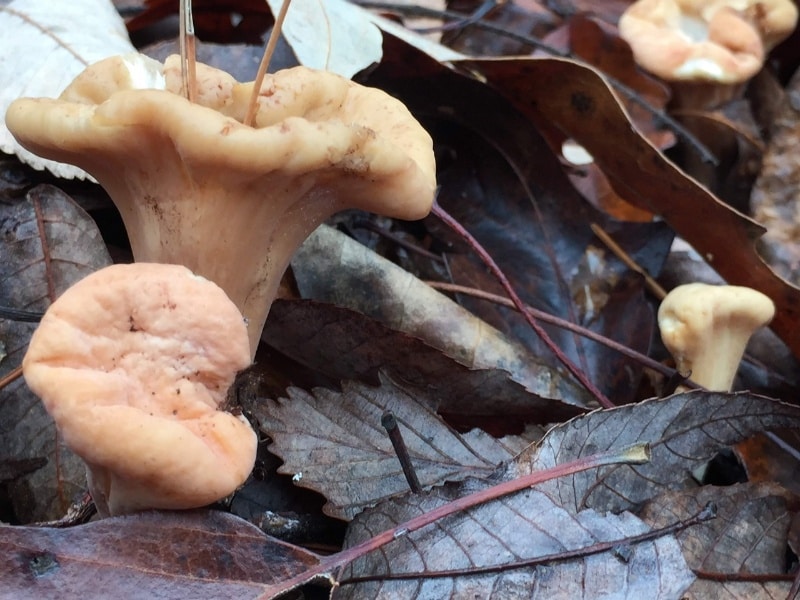
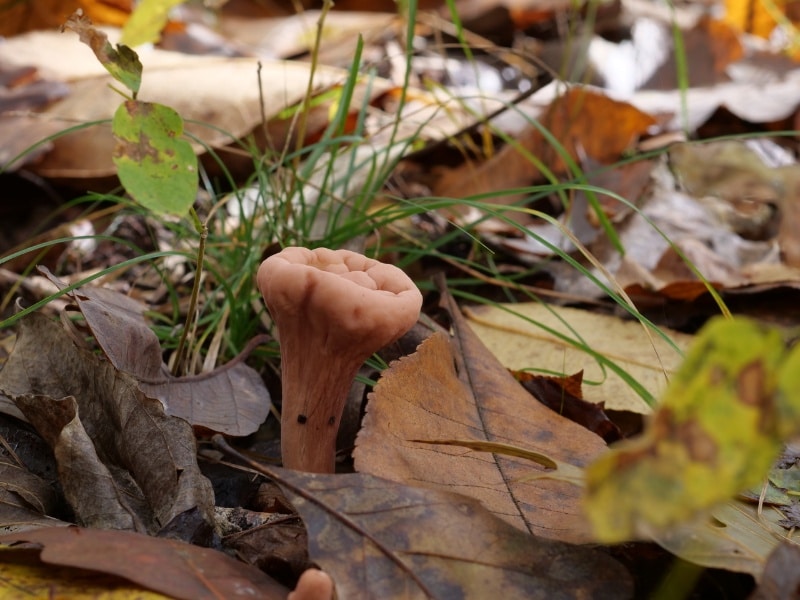
Western Club Coral (Clavariadelphus occidentalis)
Like all the other club mushrooms, the western club coral has a unique club-like or column-shaped fruiting body. It grows upright and can reach heights of 4 to 8 inches (10 to 20 cm). The fungus starts relatively slender at the base and gradually widens towards the top, giving it its characteristic club shape.
The color of the western club coral varies, but it typically ranges from pale yellow to light orange or even pinkish-buff. As the fungus matures, it may turn darker, especially towards the top. The surface is generally smooth but can become slightly wrinkled or furrowed with age. The body of the western club coral stains reddish to purplish brown when handled.
When young, the fruiting body is white, firm, and solid. As it ages, the interior becomes more hollow and spongy. The flesh stains pale brown when cut. The spore print is white.
The western club coral mushrooms are found in western North America. They fruit on the ground in association with conifers.
This species was classified as Clavariadelphus pistillaris until the late 1980s, when it was separated out. Many guides might still have them listed as the same species.
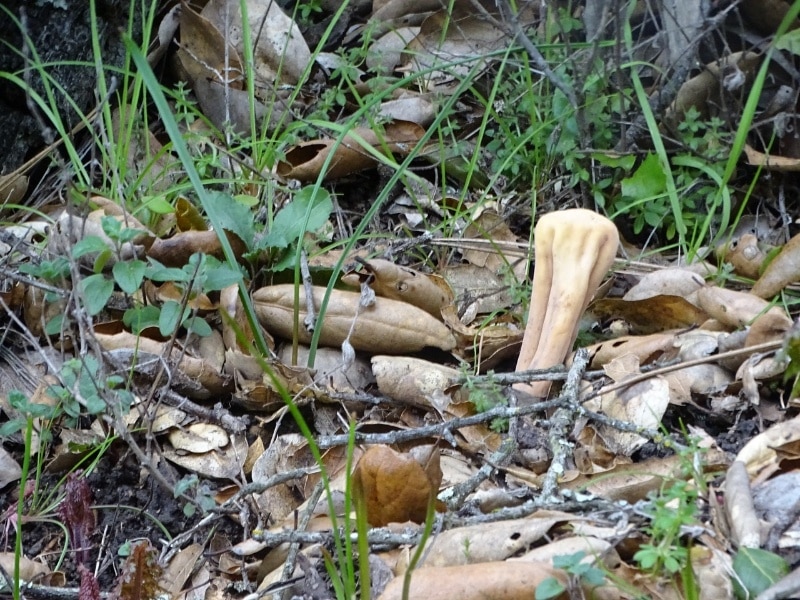
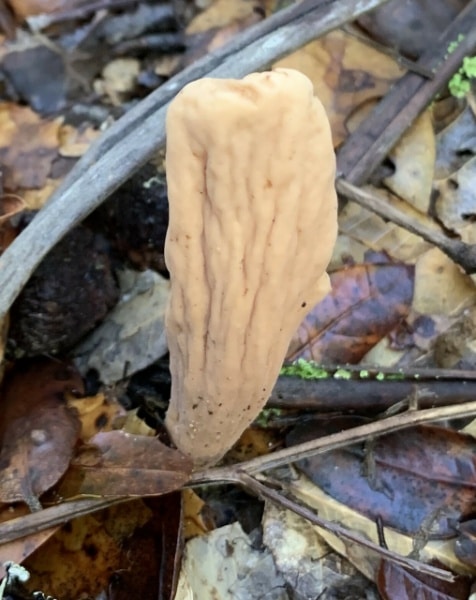
Club Mushroom Lookalikes
Chanterelles (Cantharellus spp.)
Chanterelle and club mushrooms have enough similarities that beginner (or super hopeful!) foragers might confuse them. Close inspection can quickly determine which one you have.
Chanterelles are known for their vibrant golden-yellow color, which can range from pale yellow to deep orange. They have a funnel-shaped cap with wavy, irregular edges that curve downward. The cap size typically ranges from 2 to 6 inches in diameter. One of the most distinctive features of chanterelles is their false gills, which appear as shallow, forked ridges running down the stem. These ridges are blunt and rounded, unlike the sharp, knife-like gills found in many other mushrooms.
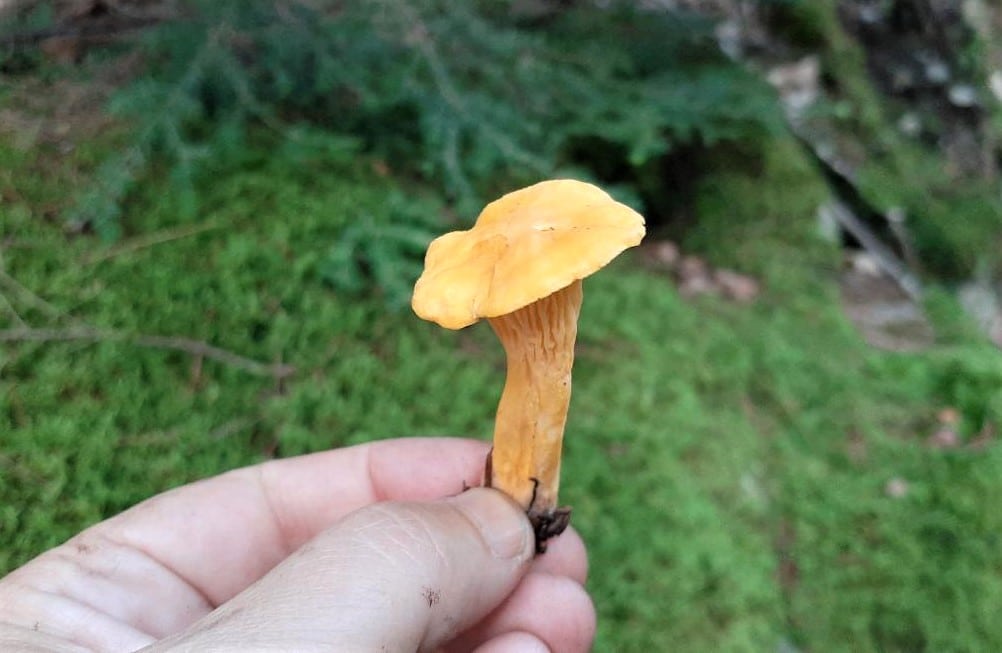
Unlike chanterelles, Clavariadelphus doesn’t have a distinct cap and stem structure. Instead, they have a smooth, cylindrical body that gradually widens towards the top. It resembles an elongated cone or club more than a funnel or vase. The color of Clavariadelphus can vary from pale yellow to pinkish-brown.
Another key difference is the texture of these mushrooms. Chanterelles have a firm, slightly fibrous flesh with a fruity aroma often compared to apricots. Clavariadelphus, in contrast, has slightly spongy flesh that is more brittle and can be easily broken. They also lack the distinctive fruity scent of chanterelles.
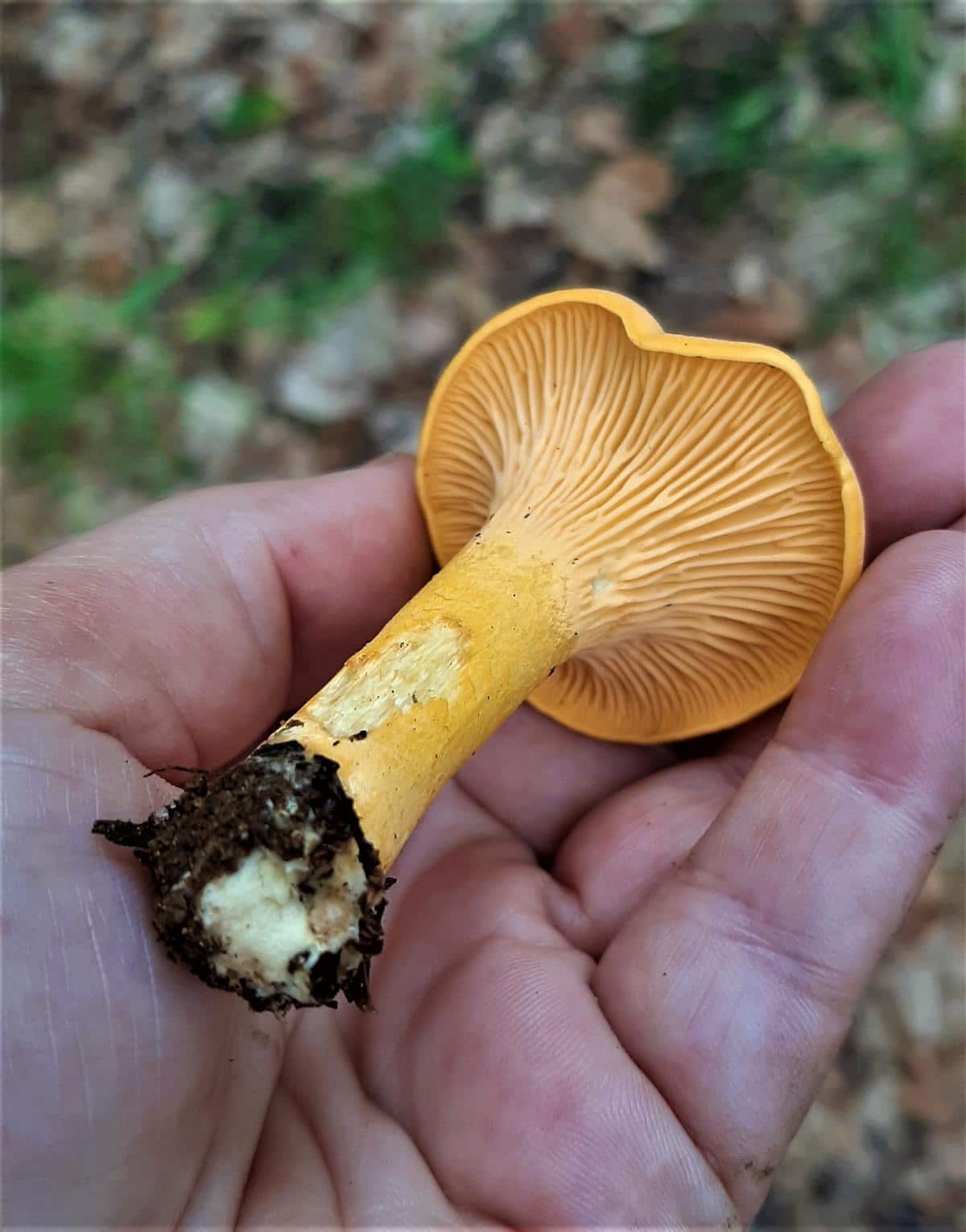
Scaly Vase (Turbinellus)
Turbinellus was formerly classified under the genus Gomphus, which is the same genus Clavariadelphus is in. They are known for their distinctive funnel-shaped or vase-like fruiting bodies. The scaly vase is the most common of these. The mushrooms typically grow 10-12 inches tall with the top “cap” section 3-8 inches wide. When young, the top of the cap may be flat, but with age, it becomes more like a vase or funnel with a deep indentation.
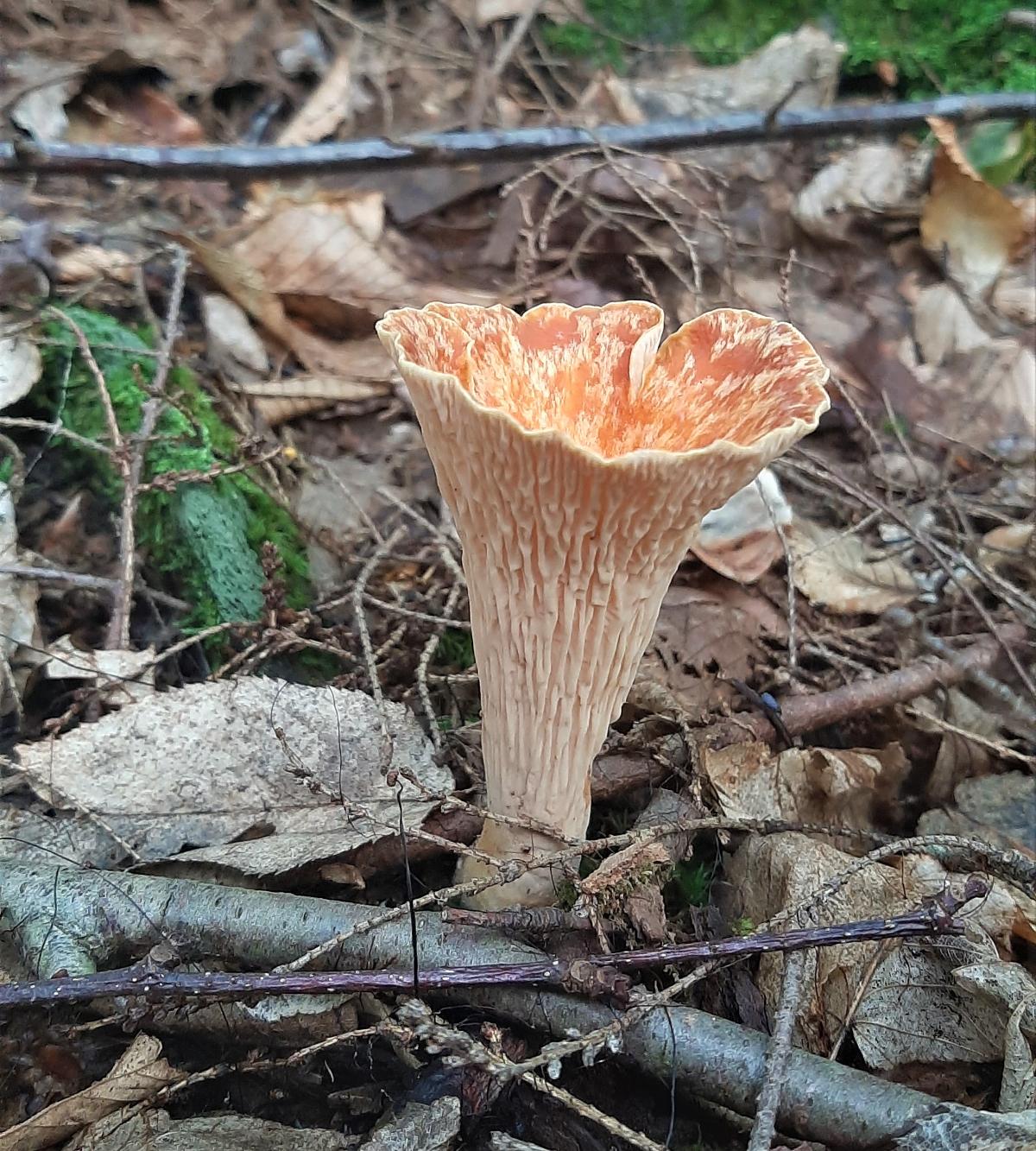
The cap surface is often wrinkled or ridged, giving it a somewhat brain-like appearance. The underside of the cap features decurrent gills or gill-like folds that run down the stem. Turbinellus species are usually found in various shades of brown, from pale tan to dark chocolate, sometimes with a pinkish or purplish tinge.
Unlike the broad funnel-like caps of Turbinellus, Clavariadelphus species grow upright, resembling slender clubs or elongated carrots. These fruiting bodies can range from 2 to 8 inches in height and are typically 0.5 to 2 inches wide at their thickest point. Turbinellus species are much larger than club mushrooms.
The surface of Clavariadelphus is smooth or slightly wrinkled and lacks the pronounced ridges or folds found in Turbinellus. They often have colors ranging from pale yellow to orange or brown.
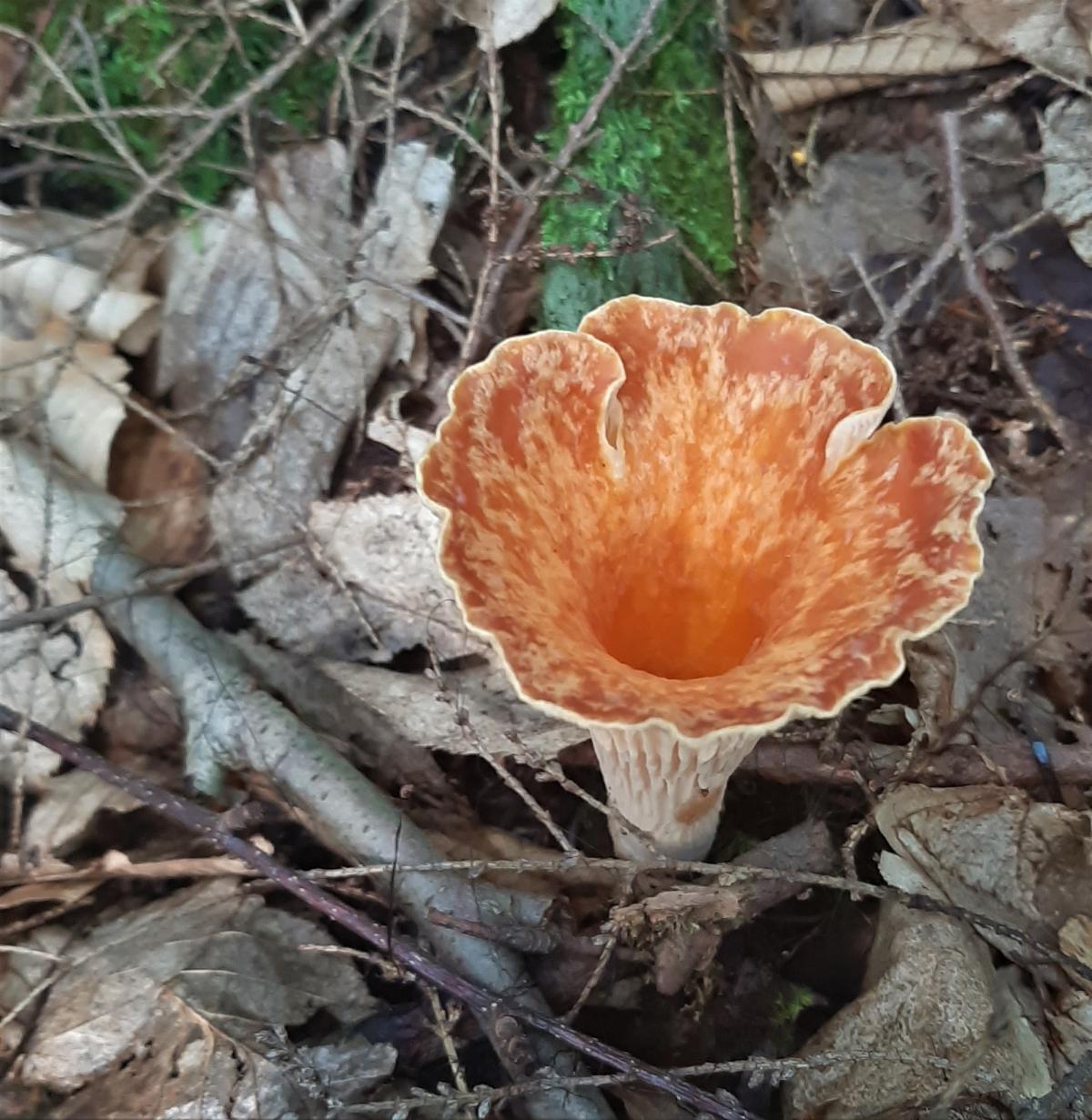
Edibility of Club Mushrooms
Some Clavariadelphus species are edible. In general, though, they aren’t usually foraged due to their size and lack of substance. One main exception is Clavariadelphus truncatus because of its sweet taste, which makes it a treat.
Timing makes all the difference when you’re picking these fungi. Older mushrooms get spongy and soft, which really changes how they taste and feel. Your best bet is to look for younger specimens that are still firm and sweet.
Medicinal Uses of Club Mushrooms
Scientists have made exciting new discoveries about the medicinal uses of club mushrooms. Clavariadelphus truncatus contains clavaric acid. This compound shows promise in cancer treatment because it interacts with farnesyltransferase, an enzyme that helps form tumors.
Scientists found a network of antioxidant compounds, with pistillarin standing out as a powerful compound that chelates iron effectively. C. pistillaris stands out with its high levels of antioxidants and essential fatty acids. These features make it a promising candidate for nutraceuticals or functional foods that go beyond simple nutrition.
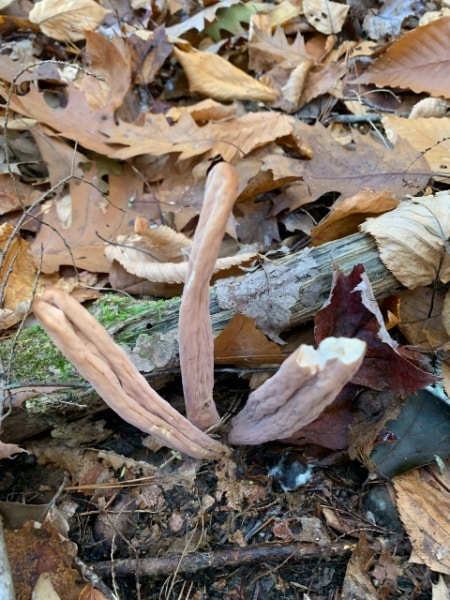
Common Questions About Club Mushrooms
Are club mushrooms safe to eat?
Some Clavariadelphus species are edible. Clavariadelphus truncatus is particularly appreciated for its sweet taste. It’s important to properly identify the species and choose fresh, firm specimens for the best eating.
Are club mushrooms medicinal?
Club mushrooms (Clavariadelphus) have shown promising medicinal properties, including antitumor effects, antioxidant properties, and potential cancer-fighting compounds. They also contain essential amino acids, high-quality proteins, and beneficial trace elements like zinc and selenium.

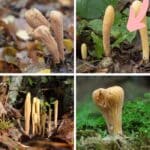
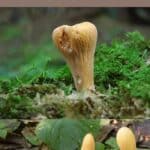



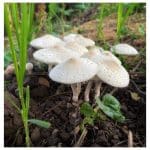
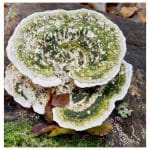
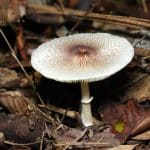
Leave a Reply